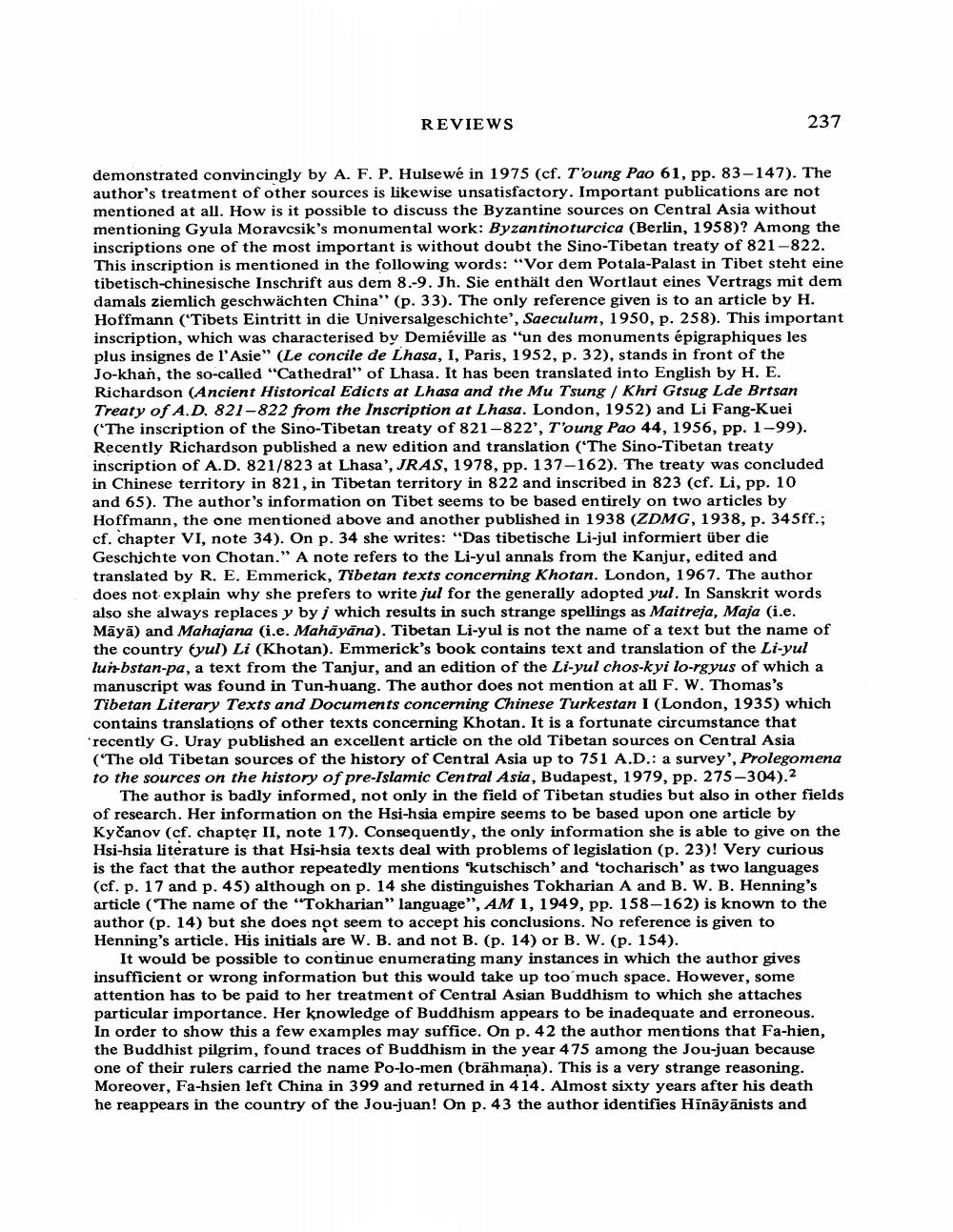________________
REVIEWS
237
demonstrated convincingly by A. F. P. Hulsewé in 1975 (cf. T'oung Pao 61, pp. 83-147). The author's treatment of other sources is likewise unsatisfactory. Important publications are not mentioned at all. How is it possible to discuss the Byzantine sources on Central Asia without mentioning Gyula Moravcsik's monumental work: Byzantinoturcica (Berlin, 1958)? Among the inscriptions one of the most important is without doubt the Sino-Tibetan treaty of 821-822. This inscription is mentioned in the following words: "Vor dem Potala-Palast in Tibet steht eine tibetisch-chinesische Inschrift aus dem 8.-9. Jh. Sie enthält den Wortlaut eines Vertrags mit dem damals ziemlich geschwächten China" (p. 33). The only reference given is to an article by H. Hoffmann ('Tibets Eintritt in die Universalgeschichte', Saeculum, 1950, p. 258). This important inscription, which was characterised by Demiéville as "un des monuments épigraphiques les plus insignes de l'Asie" (Le concile de Lhasa, I, Paris, 1952, p. 32), stands in front of the Jo-khan, the so-called "Cathedral" of Lhasa. It has been translated into English by H. E. Richardson (Ancient Historical Edicts at Lhasa and the Mu Tsung / Khri Gtsug Lde Brtsan Treaty of A.D. 821-822 from the Inscription at Lhasa. London, 1952) and Li Fang-Kuei ("The inscription of the Sino-Tibetan treaty of 821-822', T'oung Pao 44, 1956, pp. 1-99). Recently Richardson published a new edition and translation (“The Sino-Tibetan treaty inscription of A.D. 821/823 at Lhasa', JRAS, 1978, pp. 137-162). The treaty was concluded in Chinese territory in 821, in Tibetan territory in 822 and inscribed in 823 (cf. Li, pp. 10 and 65). The author's information on Tibet seems to be based entirely on two articles by Hoffmann, the one mentioned above and another published in 1938 (ZDMG, 1938, p. 345ff.; cf. chapter VI, note 34). On p. 34 she writes: "Das tibetische Li-jul informiert über die Geschichte von Chotan." A note refers to the Li-yul annals from the Kanjur, edited and translated by R. E. Emmerick, Tibetan texts concerning Khotan. London, 1967. The author does not explain why she prefers to write jul for the generally adopted yul. In Sanskrit words also she always replaces y by which results in such strange spellings as Maitreja, Maja (i.e. Māyā) and Mahajana (i.e. Mahayana). Tibetan Li-yul is not the name of a text but the name of the country tyul) Li (Khotan). Emmerick's book contains text and translation of the Li-yul lun-bstan-pa, a text from the Tanjur, and an edition of the Li-yul chos-kyi lo-rgyus of which a manuscript was found in Tun-huang. The author does not mention at all F. W. Thomas's Tibetan Literary Texts and Documents concerning Chinese Turkestan I (London, 1935) which contains translations of other texts concerning Khotan. It is a fortunate circumstance that *recently G. Uray published an excellent article on the old Tibetan sources on Central Asia ('The old Tibetan sources of the history of Central Asia up to 751 A.D.: a survey', Prolegomena to the sources on the history of pre-Islamic Central Asia, Budapest, 1979, pp. 275-304).2
The author is badly informed, not only in the field of Tibetan studies but also in other fields of research. Her information on the Hsi-hsia empire seems to be based upon one article by Kyčanov (cf. chapter II, note 17). Consequently, the only information she is able to give on the Hsi-hsia literature is that Hsi-hsia texts deal with problems of legislation (p. 23)! Very curious is the fact that the author repeatedly mentions 'kutschisch' and 'tocharisch' as two languages (cf. p. 17 and p. 45) although on p. 14 she distinguishes Tokharian A and B. W. B. Henning's article ('The name of the "Tokharian" language", AM 1, 1949, pp. 158-162) is known to the author (p. 14) but she does not seem to accept his conclusions. No reference is given to Henning's article. His initials are W. B. and not B. (p. 14) or B. W. (p. 154).
It would be possible to continue enumerating many instances in which the author gives insufficient or wrong information but this would take up too much space. However, some attention has to be paid to her treatment of Central Asian Buddhism to which she attaches particular importance. Her knowledge of Buddhism appears to be inadequate and erroneous. In order to show this a few examples may suffice. On p. 42 the author mentions that Fa-hien, the Buddhist pilgrim, found traces of Buddhism in the year 475 among the Jou-juan because one of their rulers carried the name Po-lo-men (brāhmaṇa). This is a very strange reasoning. Moreover, Fa-hsien left China in 399 and returned in 414. Almost sixty years after his death he reappears in the country of the Jou-juan! On p. 43 the author identifies Hināyānists and




